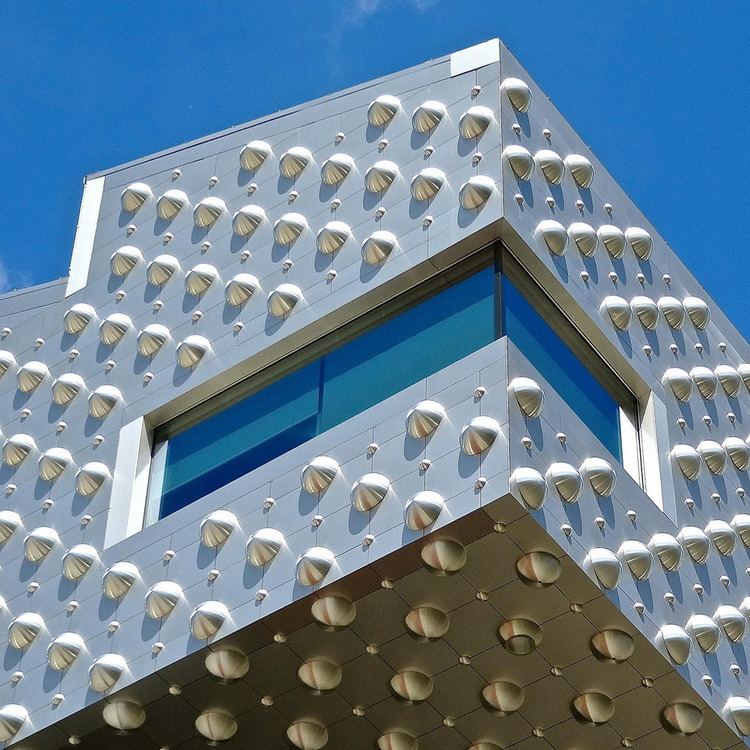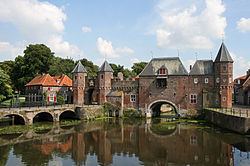Country | Population 146,592 (2011) Area 63.86 km2 | |
 | ||
Points of interest Flehite, DierenPark Amersfoort, The Mondriaan House | ||
Map of Amersfoort
Amersfoort [ˈaːmərsfoːrt] is a municipality and the second largest city of the province of Utrecht in central Netherlands. The city is growing quickly but has a well-preserved and protected medieval centre. Amersfoort is one of the largest railway junctions in the country, because of its location on two of the Netherlands' main east-west and north-south rail lines. It marked its 750th anniversary as a city in 2009.
Contents
- Map of Amersfoort
- Bicycle trip amersfoort via nijkerk putten and ermelo to harderwijk anpeh
- Nomys frozen yogurt amersfoort
- Population centres
- History
- Second World War
- Origin of Keistad Boulder city
- Nieuw Amersfoort
- Museums
- Sports
- Other
- Bus
- Rail
- Road
- Water
- Local government
- Economy
- Notable residents
- Sister cities
- References

Bicycle trip amersfoort via nijkerk putten and ermelo to harderwijk anpeh
Nomys frozen yogurt amersfoort
Population centres
The municipality of Amersfoort consists of the following cities, towns, villages and/or districts: Bergkwartier, Bosgebied, Binnenstad, Hoogland, Hoogland-West, Kattenbroek, Kruiskamp, de Koppel, Liendert, Rustenburg, Nieuwland, Randenbroek, Schuilenburg, Schothorst, Soesterkwartier, Vathorst, Hooglanderveen, Vermeerkwartier, Leusderkwartier, Zielhorst and Stoutenburg-Noord.
History
Hunter gatherers set up camps in the Amersfoort region in the Mesolithic period. Archaeologists have found traces of these camps, such as the remains of hearths, and sometimes microlithic flint objects, to the north of the city.
Remains of settlements in the Amersfoort area from around 1000 BC have been found, but the name Amersfoort, after a ford in the Amer River, today called the Eem, did not appear until the 11th century. The city grew around what is now known as the central square, the Hof, where the Bishops of Utrecht established a court in order to control the "Gelderse Vallei" area. It was granted city rights in 1259 by the bishop of Utrecht, Henry I van Vianden. A first defensive wall, made out of brick, was finished around 1300. Soon after, the need for enlargement of the city became apparent and around 1380 the construction of a new wall was begun and completed around 1450. The famous Koppelpoort, a combined land and water gate, is part of this second wall. The first wall was demolished and houses were built in its place. Today's Muurhuizen (wallhouses) Street is at the exact location of the first wall; the fronts of the houses are built on top of the first city wall's foundations.
The Onze-Lieve-Vrouwentoren tower (The Tower of Our Lady) is one of the tallest medieval church towers in the Netherlands at 98 metres (322 ft). The construction of the tower and the church was started in 1444. The church was destroyed by an explosion in 1787, but the tower survived, and the layout of the church still can be discerned today through the use of different types of stone in the pavement of the open space that was created. It is now the reference point of the RD coordinate system, the coordinate grid used by the Dutch topographical service: the RD coordinates are (155.000, 463.000).
The inner city of Amersfoort has been preserved well since the Middle Ages. Apart from the Onze-Lieve-Vrouwetoren, the Koppelpoort, and the Muurhuizen (Wall-houses), there is also the Sint-Joriskerk (Saint George's church), the canal-system with its bridges, as well as medieval and other old buildings; many are designated as national monuments. In the Middle Ages, Amersfoort was an important centre for the textile industry, and there were a large number of breweries.
In the 18th century the city flourished because of the cultivation of tobacco, but from about 1800 onwards began to decline. The decline was halted by the establishment of the first railway connection in 1863, and, some years later, by the building of a substantial number of infantry and cavalry barracks, which were needed to defend the western cities of the Netherlands. After the 1920s growth stalled again, until in 1970 the national government designated Amersfoort, then numbering some 70,000 inhabitants, as a "growth city". In 2009 the population was 140,000 plus, with an expected 150,000 by 2012.
Second World War
Since Amersfoort was the largest garrison town in the Netherlands before the outbreak of the Second World War, with eight barracks, and part of the main line of defence, the whole population of then 43,000 was evacuated ahead of the expected invasion by the Germans in May 1940. After four days of battle, the population was allowed to return.
There was a functioning Jewish community in the town, at the beginning of the war numbering about 700 people. Half of them were deported and killed, mainly in Auschwitz and Sobibor. In 1943, the synagogue, dating from 1727, was severely damaged on the orders of the then Nazi-controlled city government. It was restored and opened again after the war, and has been served since by a succession of rabbis.
There was a Nazi concentration camp near the city of Amersfoort during the war. The camp, officially called Polizeiliches Durchgangslager Amersfoort (Police Transit Camp Amersfoort), better known as Kamp Amersfoort, was actually located in the neighbouring municipality of Leusden. After the war the leader of the camp, Joseph Kotälla, served a life sentence in prison. He died in captivity in 1979. Some of the victims of the camp are buried in Rusthof cemetery near the town. Among the victims were prisoners-of-war from the Soviet Union, including 101 Central Asians, mostly Uzbeks or citizens of Samarqand. Locals would commemorate them, but the identity of the 101 soldiers was not known, until journalist Remco Reiding started investigating this case in 1999, after hearing about the cemetery. Amongst the few remaining people who witnessed the 101 soldiers is Henk Broekhuizen.
Origin of Keistad (Boulder-city)
The nickname for Amersfoort, Keistad (boulder-city), originates in the Amersfoortse Kei, a 9-tonne (19,842 lb) boulder that was dragged from the Soest moors into the city in 1661 by 400 people because of a bet between two landowners. The people got their reward when the winner bought everyone beer and pretzels. Other nearby towns then nicknamed the people of Amersfoort Keientrekker (boulder-dragger/puller). This story embarrassed the inhabitants, and they buried the boulder in the city in 1672, but after it was found again in 1903 it was placed in a prominent spot as a monument. There are not many boulders in the Netherlands, so it can be regarded as an icon.
Nieuw Amersfoort
One of the six Dutch towns established in the 17th Century in what is now Brooklyn was called "Nieuw Amersfoort" (New Amersfoort). However, unlike other Dutch names which were retained up to the present, Nieuw Amersfoort is now called "Flatlands".
Museums
Sports
Amersfoort had its own professional football (soccer) club named HVC. It was founded on 30 July 1973, but disbanded on 30 June 1982 because of financial problems. The city also hosted the riding part of the modern pentathlon event for the 1928 Summer Olympics. Amersfoort also hosted the Dutch Open (tennis) tournament from 2002 till its end in 2008.
Other
The city has a zoo, DierenPark Amersfoort, which was founded in 1948. Amersfoort is the greenest city in the Netherlands.
Bus
Bus services are provided by 3 firms: U-OV, Connexxion and Syntus. Connexxion provides services in town and to some destinations in the province of Utrecht, while Syntus offers connections to the province of Gelderland.
Rail
Amersfoort has three railway stations:
Road
Two major motorways pass Amersfoort:
Water
The river Eem (pronounced roughly "aim") begins in Amersfoort, and the town has a port for inland water transport. The Eem connects to the nearby Eemmeer (Lake Eem). The Valleikanaal drains the eastern Gelderse Vallei and joins with other sources to form the Eem in Amersfoort.
Local government
The municipal council of Amersfoort consists of 39 seats, which are divided as follows:
The city has a court of first instance (kantongerecht) and a regional chamber of commerce.
Economy
The city is a main location for several international companies:
It also has a number of non-governmental organizations and foundations:
